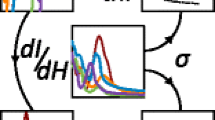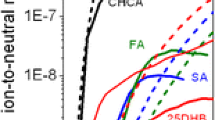Abstract
The success of matrix-assisted laser desorption/ionization mass spectrometry (MALDI-MS) as a widely employed analytical tool in the biomolecular sciences builds strongly on an effective laser–material interaction that is resulting in a soft co-desorption and ionization of matrix and imbedded biomolecules. To obtain a maximized ion yield for the analyte(s) of interest, in general both wavelength and fluence need to be tuned to match the specific optical absorption profile of the used matrix. However, commonly only lasers with fixed emission wavelengths of either 337 or 355 nm are used for MALDI-MS. Here, we employed a wavelength-tunable dye laser and recorded both the neutral material ejection and the MS ion data in a wide wavelength and fluence range between 280 and 377.5 nm. α-Cyano-4-hydroxycinnamic acid (HCCA), 4-chloro-α-cyanocinnamic acid (ClCCA), α-cyano-2,4-difluorocinnamic acid (DiFCCA), and 2,5-dihydroxybenzoic acid (DHB) were investigated as matrices, and several peptides as analytes. Recording of the material ejection was achieved by adopting a photoacoustic approach. Relative ion yields were derived by division of photoacoustic and ion signals. In this way, distinct wavelength/fluence regions can be identified for which maximum ion yields were obtained. For the tested matrices, optimal results were achieved for wavelengths corresponding to areas of high optical absorption of the respective matrix and at fluences about a factor of 2–3 above the matrix- and wavelength-dependent ion detection threshold fluences. The material ejection as probed by the photoacoustic method is excellently fitted by the quasithermal model, while a sigmoidal function allows for an empirical description of the ion signal–fluence relationship.

ᅟ




Similar content being viewed by others
References
Karas, M., Bachmann, D., Hillenkamp, F.: Influence of the wavelength in high-irradiance ultraviolet-laser desorption mass-spectrometry of organic-molecules. Anal. Chem. 57, 2935–2939 (1985)
Beavis, R.C., Chaudhary, T., Chait, B.T.: α-Cyano-4-hydroxycinnamic acid as a matrix for matrix assisted laser desorption mass spectrometry. Org. Mass Spectrom. 27, 156–158 (1992)
Dreisewerd, K.: The desorption process in MALDI. Chem. Rev. 103, 395–425 (2003)
Soltwisch, J., Jaskolla, T.W., Hillenkamp, F., Karas, M., Dreisewerd, K.: Ion yields in UV-MALDI mass spectrometry as a function of excitation laser wavelength and optical and physico-chemical properties of classical and halogen-substituted MALDI matrixes. Anal. Chem. 84, 6567–6576 (2012)
Wiegelmann, M., Soltwisch, J., Jaskolla, T.W., Dreisewerd, K. Matching the laser wavelength to the absorption properties of matrices increases the ion yield in UV-MALDI mass spectrometry. Anal. Bioanal. Chem. 2012, in press doi 10.1007/s00216-012-6478-5.
Horneffer, V., Dreisewerd, K., Lüdemann, H.C., Hillenkamp, F., Lage, M., Strupat, K.: Is the incorporation of analytes into matrix crystals a prerequisite for matrix-assisted laser desorption/ionization mass spectrometry? A study of five positional isomers of dihydroxybenzoic acid. Int. J. Mass Spectrom. 185, 859–870 (1999)
Allwood, D.A., Dreyfus, R.W., Perera, I.K., Dyer, P.E.: UV optical absorption of matrices used for matrix-assisted laser desorption/ionization. Rapid Commun. Mass Spectrom. 10, 1575–1578 (1996)
Wu, K.J., Steding, A., Becker, C.H.: Matrix-assisted laser desorption time-of-flight mass spectrometry of oligonucleotides using 3-hydroxypicolinic acid as an ultraviolet-sensitive matrix. Rapid Commun. Mass Spectrom. 7, 142–146 (1992)
Chen, X.J., Carroll, J.A., Beavis, R.C.: Near-ultraviolet-induced matrix-assisted laser desorption/ionization as a function of wavelength. J. Am. Soc. Mass Spectrom. 9, 885–891 (1998)
Qiao, H., Spicer, V., Ens, W.: The effect of laser profile, fluence, and spot size on sensitivity in orthogonal‐injection matrix‐assisted laser desorption/ionization time‐of‐flight mass spectrometry. Rapid Commun. Mass Spectrom. 22, 2779–2790 (2008)
Mowry, C.D., Johnston, M.V.: Simultaneous detection of ions and neutrals produced by matrix-assisted laser desorption. Rapid Commun. Mass Spectrom. 7, 569–575 (1993)
Puretzky, A.A., Geohegan, D.B., Hurst, G.B., Buchanan, M.V., Luk’yanchuk, B.S.: Imaging of vapor plumes produced by matrix-assisted laser desorption: a plume sharpening effect. Phys. Rev. Lett. 83, 444–447 (1999)
Dreisewerd, K., Schürenberg, M., Karas, M., Hillenkamp, F.: Influence of the laser intensity and spot size on the desorption of molecules and ions in matrix-assisted laser-desorption ionization with a uniform beam profile. Int. J. Mass Spectrom. Ion Process. 141, 127–148 (1995)
Rohlfing, A., Leisner, A., Hillenkamp, F., Dreisewerd, K.: Investigation of the desorption process in UV matrix-assisted laser desorption/ionization with a liquid 3-nitrobenzyl alcohol matrix by photoacoustic analysis, fast-flash imaging, and UV-laser post-ionization. J. Phys. Chem. C 114, 5367–5381 (2010)
Quist, A., Huth-Fehre, T., Sundqvist, B.: Total yield measurements in matrix-assisted laser-desorption using a quartz-crystal microbalance. Rapid Commun. Mass Spectrom. 8, 149–154 (1994)
Haulenbeek, J.R. Exploration of the effects of electrospray deposition spraying parameters and incident laser wavelength on matrix-assisted laser desorption ionization time-of-flight mass spectrometry; Ph.D. thesis, Drexel University, Philadelphia, PA, (2012)
Heise, T., Yeung, E.: Dynamics of Matrix-assisted laser-desorption as revealed by the associated acoustic-signal. Anal. Chim. Acta 299, 377–385 (1995)
Rohlfing, A., Menzel, C., Kukreja, L.M., Hillenkamp, F., Dreisewerd, K.: Photoacoustic analysis of matrix-assisted laser desorption/ionization processes with pulsed infrared lasers. J. Phys. Chem. B 107, 12275–12286 (2003)
Zhigilei, L.V., Garrison, B.J.: Microscopic mechanisms of laser ablation of organic solids in the thermal and stress confinement irradiation regimes. J. Appl. Phys. 88, 1281–1298 (2000)
Zhigilei, L.V., Yingling, Y.G., Itina, T.E., Schoolcraft, T.A., Garrison, B.J.: Molecular dynamics simulations of matrix-assisted laser desorption—connections to experiment. Int. J. Mass Spectrom. 226, 85–106 (2003)
Knochenmuss, R., Zhigilei, L.: What determines MALDI ion yields? A molecular dynamics study of ion loss mechanisms. Anal. Bioanal. Chem. 402, 2511–2519 (2012)
Knochenmuss, R., Zhigilei, L.V.: Molecular dynamics model of ultraviolet matrix-assisted laser desorption/ionization including ionization processes. J. Phys. Chem. B 109, 22947–22957 (2005)
Knochenmuss, R., Zhigilei, L.V.: Molecular dynamics simulations of MALDI: laser fluence and pulse width dependence of plume characteristics and consequences for matrix and analyte ionization. J. Mass Spectrom. 45, 333–346 (2010)
Knochenmuss, R.: Ion formation mechanisms in UV-MALDI. Analyst 131, 966–986 (2006)
Knochenmuss, R.: A quantitative model of ultraviolet matrix-assisted laser desorption/ionization. J. Mass Spectrom. 37, 867–877 (2002)
Knochenmuss, R.: A quantitative model of ultraviolet matrix-assisted laser desorption/ionization including analyte ion generation. Anal. Chem. 75, 2199–2207 (2003)
Knochenmuss, R.: A bipolar rate equation model of MALDI primary and secondary ionization processes, with application to positive/negative analyte ion ratios and suppression effects. Int. J. Mass Spectrom. 285, 105–113 (2009)
Spengler, B., Bahr, U., Karas, M., Hillenkamp, F.: Postionization of laser-desorbed organic and inorganic-compounds in a time of flight mass-spectrometer. Anal. Instrum. 17, 173–193 (1988)
Ens, W., Mao, Y., Mayer, F., Standing, K.G.: Properties of matrix‐assisted laser desorption. measurements with a time‐to‐digital converter. Rapid Commun. Mass Spectrom. 5, 117–123 (1991)
Demirev, P., Westman, A., Reimann, C., Hakansson, P., Barofsky, D., Sundqvist, B., Cheng, Y., Seibt, W., Siegbahn, K.: Matrix-assisted laser desorption with ultra-short laser-pulses. Rapid Commun. Mass Spectrom. 6, 187–191 (1992)
Yau, P., Chan, T., Cullis, P., Colburn, A., Derrick, P.: Threshold fluences for production of positive and negative-ions in matrix-assisted laser desorption ionization using liquid and solid matrices. Chem. Phys. Lett. 202, 93–100 (1993)
Ingendoh, A., Karas, M., Killenkamp, F., Giessmann, U.: Factors affecting the resolution in matrix-assisted laser-desorption ionization mass-spectrometry. Int. J. Mass Spectrom. Ion Process. 131, 345–354 (1994)
Riahi, K., Bolbach, G., Brunot, A., Breton, F., Spiro, M., Blais, J.: Influence of laser focusing in matrix-assisted laser-desorption ionization. Rapid Commun. Mass Spectrom. 8, 242–247 (1994)
Westmacott, G., Ens, W., Hillenkamp, F., Dreisewerd, K., Schürenberg, M.: The influence of laser fluence on ion yield in matrix-assisted laser desorption ionization mass spectrometry. Int. J. Mass Spectrom. 221, 67–81 (2002)
Günther, S., Köstler, M., Schulz, O., Spengler, B.: Laser spot size and laser power dependence of ion formation in high resolution MALDI imaging. Int. J. Mass Spectrom. 294, 7–15 (2010)
Allmen, M.V., Blatter, A.: Laser-beam interactions with materials: physical principles and applications. Springer, Berlin, Germany (1995)
Vogel, A., Venugopalan, V.: Mechanisms of pulsed laser ablation of biological tissues. Chem. Rev. 103, 577–644 (2003)
Garrison, B.J., Srinivasan, R.: Microscopic model for the ablative photodecomposition of polymers by far‐ultraviolet radiation (193 nm). Appl. Phys. Lett. 44, 849–851 (1984)
Jaskolla, T.W., Lehmann, W.-D., Karas, M.: 4-Chloro-α-cyanocinnamic acid is an advanced, rationally designed MALDI matrix. Proc. Natl. Acad. Sci. U. S. A. 105, 12200–12205 (2008)
Teuber, K., Schiller, J., Fuchs, B., Karas, M., Jaskolla, T.W.: Significant sensitivity improvements by matrix optimization: a MALDI-TOF mass spectrometric study of lipids from hen egg yolk. Chem. Phys. Lipids 163, 552–560 (2010)
Loboda, A.V., Ackloo, S., Chernushevich, I.V.A.: High-performance matrix-assisted laser desorption/ionization orthogonal time-of-flight mass spectrometer with collisional cooling. Rapid Commun. Mass Spectrom. 17, 2508–2516 (2003)
Soltwisch, J., Souady, J., Berkenkamp, S., Dreisewerd, K.: Effect of gas pressure and gas type on the fragmentation of peptide and oligosaccharide ions generated in an elevated pressure UV/IR-MALDI ion source coupled to an orthogonal time-of-flight mass spectrometer. Anal. Chem. 81, 2921–2934 (2009)
Soltwisch, J., Dreisewerd, K.: An ultraviolet/infrared matrix-assisted laser desorption ionization sample stage integrating scanning knife-edge and slit devices for laser beam analysis. Rapid Commun. Mass Spectrom. 25, 1266–1270 (2011)
Wright, D.: Beamwidths of a diffracted laser using four proposed methods. Opt. Quantum Electron. 24, 1129–1135 (1992)
Rosencwaig, A., Gersho, A.: Theory of photoacoustic effect with solids. J. Appl. Phys. 47, 64–69 (1976)
Dreisewerd, K., Schürenberg, M., Karas, M., Hillenkamp, F.: Matrix-assisted laser desorption/ionization with nitrogen lasers of different pulse widths. Int. J. Mass Spectrom. Ion Process. 154, 171–178 (1996)
Puretzky, A.A., Geohegan, D.B.: Gas-phase diagnostics and LIF-imaging of 3-hydroxypicolinic acid MALDI-matrix plumes. Chem. Phys. Lett. 286, 425–432 (1998)
Puretzky, A.A., Geohegan, D.B.: LIF imaging and gas-phase diagnostics of laser desorbed MALDI-matrix plumes. Appl. Surf. Sci. 127, 248–254 (1998)
Acknowledgments
The authors thank Alexandre Loboda, Stefan Berkenkamp, Franz Hillenkamp, and Michael Karas for their support of this work. They thank Ulrich Röhling and Alexander Pirkl for technical assistance, Victor Spicer and Werner Ens (University of Manitoba) for providing the tofmulti program, Thorsten Deilmann for modifications of the program, and Richard Knochenmuss for helpful discussions. Financial support by the Deutsche Forschungsgemeinschaft (grants DR416/8-1 and DR416/9-1 to K.D. and JA2127/1-1 to T.W.J.) and the funds Innovative Medical Research of the Münster University Medical School (grant DR520805 to K.D.) is gratefully acknowledged.
Author information
Authors and Affiliations
Corresponding author
Additional information
An erratum to this article is available at http://dx.doi.org/10.1007/s13361-015-1215-x.
Electronic supplementary material
Below is the link to the electronic supplementary material.
ESM 1
(DOCX 100 kb)
Rights and permissions
About this article
Cite this article
Soltwisch, J., Jaskolla, T.W. & Dreisewerd, K. Color Matters—Material Ejection and Ion Yields in UV-MALDI Mass Spectrometry as a Function of Laser Wavelength and Laser Fluence. J. Am. Soc. Mass Spectrom. 24, 1477–1488 (2013). https://doi.org/10.1007/s13361-013-0699-5
Received:
Revised:
Accepted:
Published:
Issue Date:
DOI: https://doi.org/10.1007/s13361-013-0699-5




